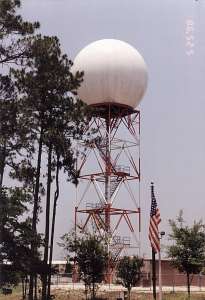Weather Radar WSR-88D
Description of the radar set, tactical-technical characteristics
| Specifications | |
|---|---|
| frequency: | 2,700 - 3,000 MHz |
| pulse repetition time (PRT): | |
| pulse repetition frequency (PRF): | 320 … 450, … 1300 Hz |
| pulsewidth (τ): | 1.57 and 4.57 µs |
| receive time: | |
| dead time: | |
| peak power: | 700 kW |
| average power: | |
| instrumented range: | 460 km |
| range resolution: | 47 m or 135 m |
| accuracy: | |
| beamwidth: | 0,96° (2,7GHz) to 0,88° (3 GHz) |
| display levels: | 15 |
| antenna rotation: | 3 rpm |
| MTBCF: | |
| MTTR: | |
Weather Radar WSR-88D
The WSR-88D (Weather Surveillance Radar) is a Doppler radar, introduced in 1988. In addition to obtaining intensity and location of weather cells, the WSR-88D makes use of the Doppler shift to determine radial velocities of individual cells. In velocity display mode, the WSR-88D is capable of determining significant wind shear as one might find in the tightly rotating column of a tornadic storm. By using the intensity mode and velocity mode together, users can determine much more information about a storm than was capable with previous radars. Mesoscale rotations which typically indicate intense thunderstorms are discernable in the velocity mode, and this enhances forecast leadtimes for the onset of severe weather. The sensitivity is about 0 dBZE at a range of 50 km. The reporting interval is a complete volume scan every 6 minutes for 15 different elevation angles.
Characteristics of the WSR-88D radar are as follows:[1]
- Antenna Sybsystem
- Diameter of the Reflector: 8.54 m (28 ft.)
- Polarisation: Horizontal
- Gain: 44.5 dB
- Maximum scan rate: 36 deg./sec
- Mechanical limits: -1 to 60 deg. elevation
- Radome diameter: 11.89 m (39 ft.)
- Radome (two way) loss: 0.3 dB
- Transmitter
- Type: master oscillator power amplifier
- using a Klystron Amplifier
- Receiver
- Type: linear
- IF: 57.6 MHz
- System noise power: -113 dBm
- Bandwidth
- Short pulse (-3dB): 0.63 MHz
- Long pulse: Digital averaging of three I & Q-Samples spaced 250 m apart
As of 2013, all 163 [2] WSR-88D systems have been upgraded to dual polarization. The first operational WSR-88D went into service in 1992 at Sterling, Virginia. The contractor who built the system was Unisys (Sperry and Burroughs merged to form Unisys in 1986).
Source:
- NOAA Radar Operations Center
- the ROC tech info page says there are 160 systems but their Level 2 data page says there's 163 systems

